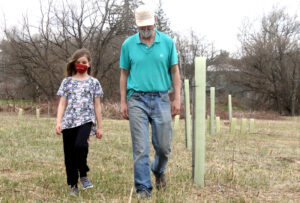GOALS: SAVE LOCAL FARMLAND, CHESAPEAKE
'Mysterious Tubes' Explained

People entering Morris on Route 23 from Oneonta kept asking Bob Thomas, town historian and a Butternut Valley Alliance board member, “What are those tubes across from the cemetery?”
With his nudging, couple of weeks ago an enticingly titled Zoom presentation, “Mysterious Tubes Along Butternut Creek,” provided the answer to 27 participants, some landowners who may sign up to host mysterious tubes of their own, according to BVA Executive Director Graham Stroh.
The program’s been going on for a decade, according to Lydia Brinkley, Upper Susquehanna Coalition buffer coordinator, “riparian buffers,” that is.
If you’ve only noticed the mysterious tubes lately, it’s because there are more of them, part of the USC’s federally and state-funded efforts to clean up Otsego County’s streams, and thus contribute a bit to the restoration of the Chesapeake Bay, 250 miles south of Garrattsville.
“Riparian buffers are essentially wooded areas along creeks and rivers, for purposes of reducing erosion and stabilizing stream banks,” said Stroh, formerly an urban planner in Washington D.C. who moved back three years ago to manage the family’s property. (He was raised in New York City; his dad, Leslie, in Morris.)
The Butternut Valley, and with the collaboration of the Middlefield-based Soil & Water Conservation District, all of Otsego County’s streams, are part of a “huge, huge region,” said Stroh, where efforts are underway to clean up the tributaries to the Susquehanna River, which eventually runs into the challenged Chesapeake, where pollutants have been destroying the rich fishery for decades.
You have reached your limit of 3 free articles
To Continue Reading
Our hard-copy and online publications cover the news of Otsego County by putting the community back into the newspaper. We are funded entirely by advertising and subscriptions. With your support, we continue to offer local, independent reporting that is not influenced by commercial or political ties.

